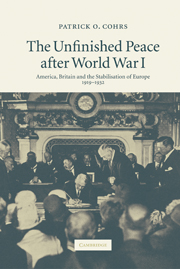Book contents
- Frontmatter
- Contents
- Acknowledgements
- List of abbreviations
- A note on the footnotes and bibliography
- Introduction
- Prologue
- 1 The wider challenges
- 2 Wilson, Lloyd George and the quest for a ‘peace to end all wars’
- 3 The ill-founded peace of 1919
- 4 The escalation of Europe's post-Versailles crisis, 1920–1923
- Part I The Anglo-American stabilisation of Europe, 1923–1924
- Part II Europe's nascent Pax Anglo-Americana, 1924–1925
- Part III The unfinished transatlantic peace order: the system of London and Locarno, 1926–1929
- 17 Sustaining stability, legitimating peaceful change
- 18 Progressive visions and limited commitments
- 19 ‘Reciprocity’?
- 20 The new European concert – and its limits
- 21 Thoiry – the failed quest for a ‘final postwar agreement’
- 22 Towards peaceful change in eastern Europe?
- 23 Achievements and constraints
- 24 No ‘new world order’
- 25 The initiation of the Young process
- 26 The last ‘grand bargain’ after World War I
- Epilogue
- Conclusion
- Map: Post-World War I Europe after the peace settlement of Versailles
- Bibliography
- Index
20 - The new European concert – and its limits
Published online by Cambridge University Press: 21 July 2009
- Frontmatter
- Contents
- Acknowledgements
- List of abbreviations
- A note on the footnotes and bibliography
- Introduction
- Prologue
- 1 The wider challenges
- 2 Wilson, Lloyd George and the quest for a ‘peace to end all wars’
- 3 The ill-founded peace of 1919
- 4 The escalation of Europe's post-Versailles crisis, 1920–1923
- Part I The Anglo-American stabilisation of Europe, 1923–1924
- Part II Europe's nascent Pax Anglo-Americana, 1924–1925
- Part III The unfinished transatlantic peace order: the system of London and Locarno, 1926–1929
- 17 Sustaining stability, legitimating peaceful change
- 18 Progressive visions and limited commitments
- 19 ‘Reciprocity’?
- 20 The new European concert – and its limits
- 21 Thoiry – the failed quest for a ‘final postwar agreement’
- 22 Towards peaceful change in eastern Europe?
- 23 Achievements and constraints
- 24 No ‘new world order’
- 25 The initiation of the Young process
- 26 The last ‘grand bargain’ after World War I
- Epilogue
- Conclusion
- Map: Post-World War I Europe after the peace settlement of Versailles
- Bibliography
- Index
Summary
1926 became a pivotal year not only for Locarno politics but also for the evolution of the Dawes system and more generally America's relations with the European powers. For that year revealed what dynamism was possible in sustaining the nascent Euro-Atlantic peace system. Above all, however, it threw into relief what obstacles – divergent interests, lack of political will and multiple constraints – still hampered its solidification. Was Locarno politics beginning to unravel before it had even really begun, because Chamberlain, Briand and Stresemann did not or could not address the underlying Franco-German problem? Was there just a semblance of Franco-German reconciliation, because Germany's growing power could ultimately not be accommodated?
In fact, it was now, in the aftermath of the security pact, that the two developments characterising international relations in the era of London and Locarno emerged. And, essentially, it was now that the politics of London and Locarno began to take root. To an equally remarkable extent, British ground-rules of political accommodation and American terms of financial consolidation came to prevail, if more so in Weimar Germany than in France or among Germany's eastern neighbours. As a result, progress in European politics and, to a lesser degree, progress in transatlantic consolidation efforts was indeed possible; and it was achieved. Yet it could only be achieved gradually and painfully. Neither European concert diplomacy nor the US-induced stabilisation of Germany, and pressure on France, produced further outcomes as groundbreaking as those of the mid-1920s. There were no further great leaps.
- Type
- Chapter
- Information
- The Unfinished Peace after World War IAmerica, Britain and the Stabilisation of Europe, 1919–1932, pp. 345 - 377Publisher: Cambridge University PressPrint publication year: 2006



